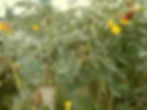Five Edible Cover Crops that Provide Food While Building the Soil
- Miguel M.LS.
- May 30, 2021
- 3 min read
Updated: Dec 19, 2025
The advantages of using cover crops to protect the soil and produce green manure are known to be many: nutrient scavenging in poor soils, soil protection from erosion, nitrogen fixation (can’t get enough legumes in a garden, can’t you?), generation of organic matter to incorporate it into the soil and weed control, among several others. But could these crops also be more like mainstream crops, a source of food? Theoretically, all cover crops should be cut down and used (either by incorporating them into the soil, being left to rot in place, or composted elsewhere) before they get to make seeds or fruits, but after they begin to flower. Still, this doesn’t mean that they can’t feed you as well, or that you can’t get at least a bite out of them in the process: here’s a list of five excellent cover crops that could make their way to your table as well.
1- Cowpea (Vigna unguiculata).
A heat-loving, drought-resistant and poor-soil-adapted plant, the humble cowpea is a powerhouse of organic matter and food production. The tender leaves are edible and have a sweet, mild taste, and you can also eat the pods and the beans of any plant that you don’t cut young. Even if you go ahead and decide to harvest cowpeas after they have grown to full maturity (bear in mind that they won’t decompose as quickly and as such, they won’t release as many nutrients for the next season, though) the organic matter produced by fully-grown cowpeas will be enough to significantly improve your soil quality by using soil fertilizers.

2- Pigeon pea (Cajanus cajan).
Pigeon peas are actually perennial species (or at least have the potential to be perennial) in warmer, tropical climates around the world. In temperate regions, however, they can be grown as annuals. This is a plant able to grow with very little water, holding its ground even with just 650 mm of rainfall per year. In immature specimens, the leaves are the edible part, although they may have too much of a strong taste for some people.

3- Austrian winter peas (Pisum sativum var. arvense).
A variety of peas, the Austrian winter peas (also called ‘field peas’) produce excellent leaves to be eaten as greens, either raw or stir-fried or prepared according to the recipe of choice. In a large enough field, the Austrian winter peas could reasonably satisfy the grower’s demands for fresh leafy greens while leaving more than enough to be returned to the soil as bio-manure (a good rule of thumb is to eat as much as 1/3 of the leaves of any cover crop, but not more). Much like cowpeas, these can also be grown to full maturity for their seeds, and their remains will still give the soil a good boost.

4- Barley (Hordeum vulgare).
Unlike the three former crops, barley is not a legume, but it is pretty darn close in terms of usefulness. Not only it is one of the crops that produce more organic matter in poor soils, but, like wheat, its young leaves can also be eaten or even desiccated and ground into a nutritious powder. They are also full of antioxidants, as a team of Japanese researchers found in 2012.

5- Oilseed radish (Raphanus sativus var. oleifer).
Radishes are another great cover crop that will provide leafy greens to the gardener, and maybe one thick root or two to pickle or to eat raw. Oilseed radish, in particular, produces roots that drill the soil and favor its decompaction and aeration while producing thick heads of greens that can be eaten like mustards. It’s better to cook them since many people find their taste too strong to eat them fresh. Most of the radishes can then be cut as close to the soil as possible, or dug up and composted over it.

Incorporating edible cover crops into your farming practices not only helps improve soil health but also provides a sustainable source of food. These crops create a symbiotic relationship between your soil and your harvest, enhancing both productivity and sustainability. By choosing the right cover crops, you can boost your farm's resilience against environmental challenges while benefiting from nutrient-rich food options. Embrace these green solutions for a healthier soil ecosystem and a more sustainable farming future.